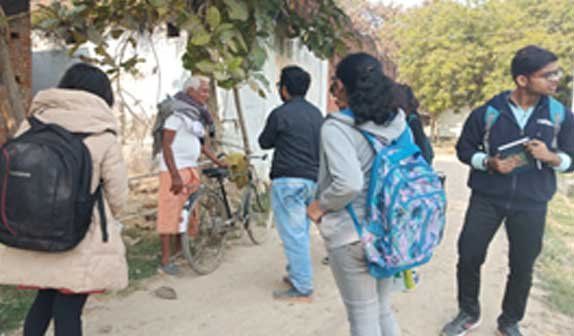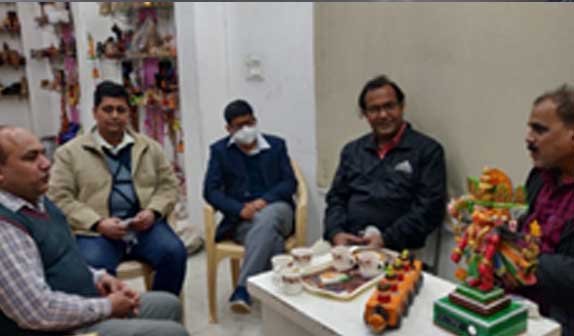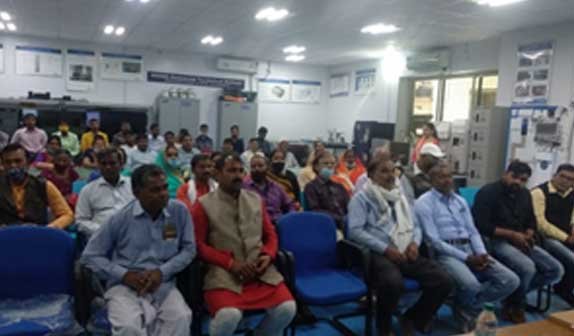
3
May
DIC Excursion to Chittauni village, Varanasi
I. Proposal by the students
IITs were established with a dream that IITs to be the face of development and transformation of India. The heart of India lies in its villages; to bring forth changes here one needs innovation and development to reach the villages. Wouldn’t it be a great idea, if we take up a village and completely transform it?
The proposed idea is to visit a village on the 9th of February, 2020. A contingent consisting of members from the Social Projects’ Club, Social Service Council and the Club of Sustainability and Innovation, Science and Technology Council will be making a visit to a village.
A survey will be conducted by the members of the excursion in the village. The students will be asking the villagers about the problems that they face in their day to day lives, especially related to that particular village.
The students will come back and organize a Brainstorming Session on the problems of that particular village and come up with solutions that bring forth a change in the same. These solutions will then be implemented in the village to transform it.
II. Date and venue of the excursion
Date: 09/02/2020
Location: Chittauni, Varanasi
III. Introduction
Design and Innovation Centre, along with the Social Projects’ Club, Social Service Council and the Club of Sustainability and Innovation, Science and Technology Council; organised a research survey on 09/02/2020 in the Chittauni village of Varanasi district, Uttar Pradesh.
The main motive of the survey was to fathom the major problems in the day to day lives of the villager of Chittauni. The survey was not to gather some numbers and fill excel sheets but get into the root causes of problems.
Agriculture, Education, Healthcare and Sanitation are the four pillars on which the society stands. Hence, these were the four domains of the questionnaire as the combined team from Social Projects’ Club and the Club of Sustainability and Innovation spend time understanding the problems in the village for eight hours.
IV. Some photographs of the event

| Faculty member: Dr. A N Sahu, and Dr. A Senthil Raja Department of Department of Pharmaceutical Engineering and Technology | |
| Ritwik Ghorui | Shivangee Pandey |
| Tanay Vilas Kohale | Srishti Sharma |
| Akarshit Magotra | Aman Mishra |
| Rishija Rishi Raj | Rohan Singh |
| Piyush Singh | Vishant Batta |
| Pranav Verma | Mohan Aditya Sabeneni |
| Sampreeth Devarakonda | Aman Kumar |
| Yashasvi | Guntipally Naveen Reddy |
| Prajwal M | Mittapally Nivesh |
| Akshay Khanna | Ankur |
| Shahib Saha
|
|
I. Some outcomes of the survey conducted by the students
A. Education
- Most of the people in the village had a basic level of literacy but many of them could not pursue their studies further due to
- The number of teachers present in the government schools and their dedication level is not sufficient to convince parents to send their children There are three private schools and even the landless labourers try to send their children to private schools.
- Kiran Society runs a skill centre in the
- Chittauni has no access to proper computer
- The government scholarships do not reach to the backward sections of the village As most of the students go to private schools, therefore they miss out on many important scholarship opportunities.
- The general perception was that the teacher had very little concern for the students in government The private schools were somewhat better in this aspect but the best work seems to be done by the Kiran Society.
- Anganwadi is present in the The students seemed to be regular both at the Anganwadi and the schools.
- Dropout rate seemed quite high in the previous generation but has come down in the present
- Most of the parents want their children to study
B. Healthcare
- Aanganwadi reported providing many facilities to the poor people in the village. But ground reports showed much of it did not reach to the people living in the slums.
- The well to do families in the village had first aid kit while the poor didn’t possess them.
- There is no government clinic nearby. For full free treatment, they have to come to a long distance to Sir Sunderlal Hospital. They go to a private doctor in a nearby town for most of the problems.
- As they go to private doctors, generally they have to bear heavy expenses. As the government hospital is very far, a lot of transportation fee has to be paid by them to get good treatments.
- Awareness about schemes like Ayushman Bharat was non-existent in the village. People are in general not aware of the Healthcare schemes of the government of India.
- Ujjwala Yojana is one of the few government’s schemes that have reached to each and every household of the village. But the problem is people are not able to afford to refill cylinders.
- Tobacco abuse and use of other intoxicant have been a very major problem of the village.
C. Agriculture
- ‘Neelgai’ a wild cattle-like animal is the main issue, they come and destroy crops. Wooden fences aren’t so effective nor is affordable by all. This animal also poses threats of attack to people passing through the village especially at night times.
- We divided the region into 5 regions demographically and surveyed, no one claimed to use consultancy services provided by the government or pursue a professional degree regarding agricultural practices and techniques.
- The produce is mainly to meet the farmer’s home requirements and very little quantity is sold for profit. This selling task is facilitated by certain contacts they have.
- The number of people practising agriculture is reducing with time, as of now. People aspire to get a stable job, and a working group prefers to work as labourers, odd jobs, etc for it ensures stability.
- Both pesticides and organics are used for agriculture. Wastes, both household and agriculture, are either dumped in pits or burned away. Cattle feed was also happening smoothly.
D. Sanitation
- The ground report showed that there is no washroom at there public places, moreover, every household couldn’t avail the benefits of the Swachh Bharat Abhiyaan and hence don’t possess washrooms.
- The washroom tanks are cleaned up every 5 years.
- The garbage is thrown into open fields and a pond is present in the village, which has highly contaminated water. The same water has seeped into the groundwater reserves and polluted it.
- Sanitary pads are thrown into the open area.
- They use GANGA CANAL water irrigation.
- They use JAL NIGAM WATER for drinking purpose, but this water has not reached the backward areas of the village.
- Water is supplied for two times a day by Jal Nigam.
- Small shelters are made for animals.
- Cow dung is used as fuel in the kitchen.
-
date
09/02/2020
-
location
-
time



